Disaster Management
The United Nations International Strategy for Disaster Reduction (UNISDR) defines disaster risk management as the systematic process of using administrative decisions, organization, operational skills and capacities to implement policies, strategies and coping capacities of the society and communities to lessen the impacts of natural hazards and related environmental and technological disasters.
Institutional Framework for Disaster Management
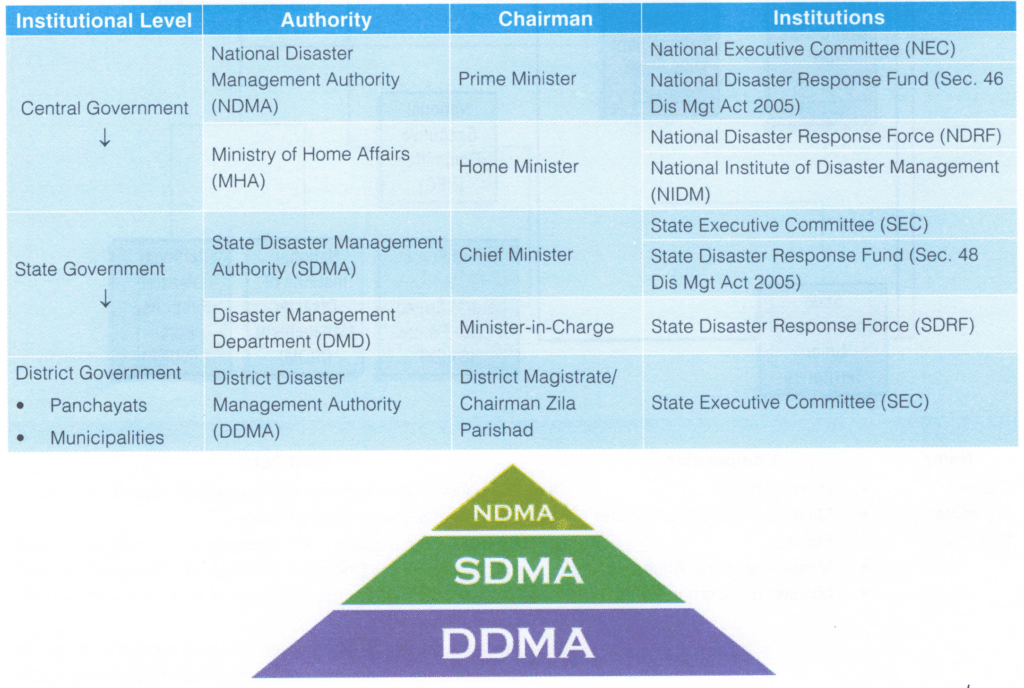
1. National Level
- The overall coordination of disaster management vests with the Ministry of Home Affairs (MHA).
- The Cabinet Committee on Security (CCS) and the National Crisis Management Committee (NCMC) are the key committees involved in the top-level decision-making with regard to disaster management.
- The NDMA is the lead agency responsible for the preparation Disaster Management plans and the execution of Disaster Management functions at the national level.
The extent of involvement of central agencies will depend upon the types, scale, administrative spread of the disaster. The Central government will provide all necessary support irrespective of the classification of the disaster, if the situation requires direct assistance from central government or the deployment of central agencies.
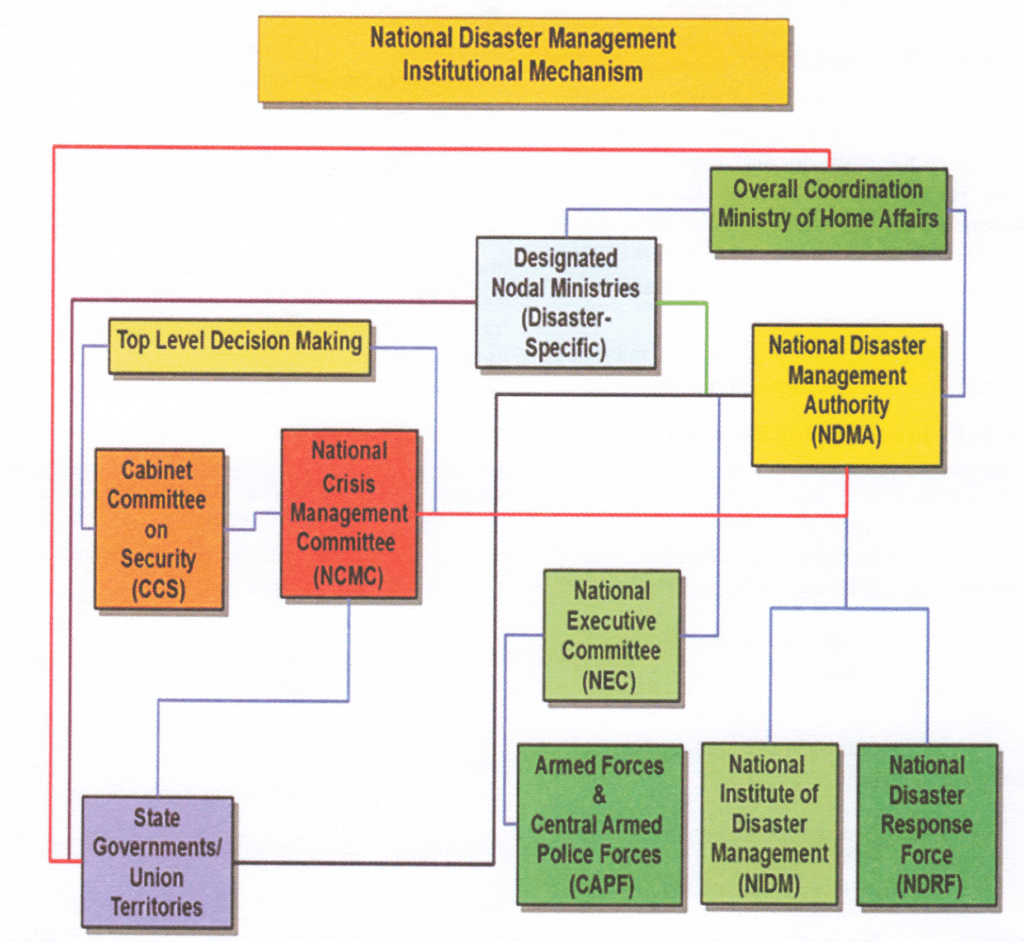
National Level Decision Making Bodies for Disaster Management
Cabinet committee on Security
- Composition
- Prime Minister
- Minister of Defence, Minister of
- Finance
- Minister of Home Affairs
- Minister of External Affairs
- Vital Role
- Evaluation from a national security perspective, if an incident has potentially security implications.
- Oversee all aspects of preparedness, mitigation and management of Chemical, Biological, Radiological and Nuclear (CBRN) emergencies and of disasters with security implications.
- Review risks of CBRN emergencies from time to time, giving directions for measures considered necessary for disaster prevention, mitigation, preparedness and effective response.
National Crisis Management Committee (NCMC)
- Composition
- Cabinet Secretary (Chairperson).
- Secretaries of Ministries / Departments and agencies with specific Disaster Management responsibilities.
- Vital Role
- Oversee the Command, Control and Coordination of the disaster response.
- Give direction to the Crisis Management Group as deemed necessary.
- Give direction for specific actions to face crisis situations.
National Disaster Management Authority (NDMA)
- Composition
- Prime Minister (Chairperson).
- Members (not exceeding nine, nominated by the Chairperson).
- Vital Role
- Oversee the Command, Control and Coordination of the disaster response.
- Give direction to the Crisis Management Group as deemed necessary.
- Give direction for specific actions to face crisis situations.
National Executive Committee (NEC)
- Composition
- Union Home Secretary (Chairperson).
- Secretaries to the GOI in the Ministries / Departments of Agriculture, Atomic Energy, Defence, Drinking Water and sanitation, Environment, Forests and Climate Change Finance (Expenditure), Health and Family Welfare, Power, Rural Development, Science and Technology, Space, Telecommunications, Urban Development, Water Resources, River Development and Ganga Rejuvenation, The Chief of the Integrated Defence Staff of the Chiefs of Staff Committee, ex officio as members.
- Secretaries in the Ministry of External Affairs, Earth Sciences, Human Resource Development, Mines, Shipping, Road Transport and Highways and Secretary, NDMA are special invitees to the meetings of the NEC.
- Vital Role
- To assist the NDMA in the discharge of its functions.
- Preparation of the National Plan.
- Coordinate and monitor the implementation of the National Policy.
- Monitor the implementation of the National Plan and the plans prepared by the Ministries or Departments of the Government of India.
- Direct any department or agency of the Govt, to make available to the NDMA or State Disaster Management Authorities such men, material or resources as are available with it for the purpose of emergency response, rescue and relief.
- Ensure compliance of the directions issued by the Central Government.
- Coordinate response in the event of any threatening disaster situation or disaster
- Direct the relevant Ministries / Departments of the Gol, the State Governments and the SDMAs regarding measures to be taken in response to any specific threatening disaster situation or disaster.
- Coordinate with relevant Central Ministries/ Departments/Agencies which are expected to provide assistance to the affected State as per Standard Operating Procedures (SOPs).
- Coordinate with the Armed Forces, Central Armed Police Forces (CAPF), the National Disaster Response Force (NDRF) and other uniformed services which comprise the Gol’s response to aid the State authorities.
- Coordinate with India Meteorological Department (IMD) and a number of other specialised scientific institutions which constitute key early warning and monitoring agencies.
- Coordinate with Civil Defence volunteers, home guards and fire services, through the relevant administrative departments of the State Governments.
National Disaster Response Force (NDRF)
- Composition
- Specially trained force headed by a Director General Structured like para military forces for rapid deployment.
- Vital Role
- Provide assistance to the relevant State Government/District Administration in the event of an imminent hazard event or in its aftermath.
National Institute of Disaster Management (NIDM)
- Composition
- Union Home Minister
- Vice Chairman, NDMA
- Members including Secretaries of various nodal Ministries and Departments of Government of India and State Governments and heads of national levels scientific, research and technical organizations, besides eminent scholars, scientists and practitioners.
- Vital Role
- Human resource development and capacity building for disaster management within the broad policies and guidelines laid down by the NDMA.
- Design, develop and implement training programmes.
- Undertake research.
- Formulate and implement a comprehensive human resource development plan.
- Provide assistance in national policy formulation, assist other research and training institutes, state governments and other organizations for successfully discharging their responsibilities.
- Develop educational materials for dissemination.
- Promote awareness generation.
2. State Level
The Disaster Management Act 2005 mandates that:
- Each state in India shall have its own institutional framework for disaster management.
- Each State Government shall take necessary steps for the preparation of state Disaster Management plans, integration of measures for prevention of disasters or mitigation into state development plans, allocation of funds.
- The State Government shall also assist the Central Government and central agencies in various aspects of Disaster Management.
- Each state shall prepare its own State Disaster Management Plan.
- Setting up of a State Disaster Management Authority with the Chief Minister as the ex officio Chairperson. Similar system will function in each Union Territory with Lieutenant Governor as the Chairperson.
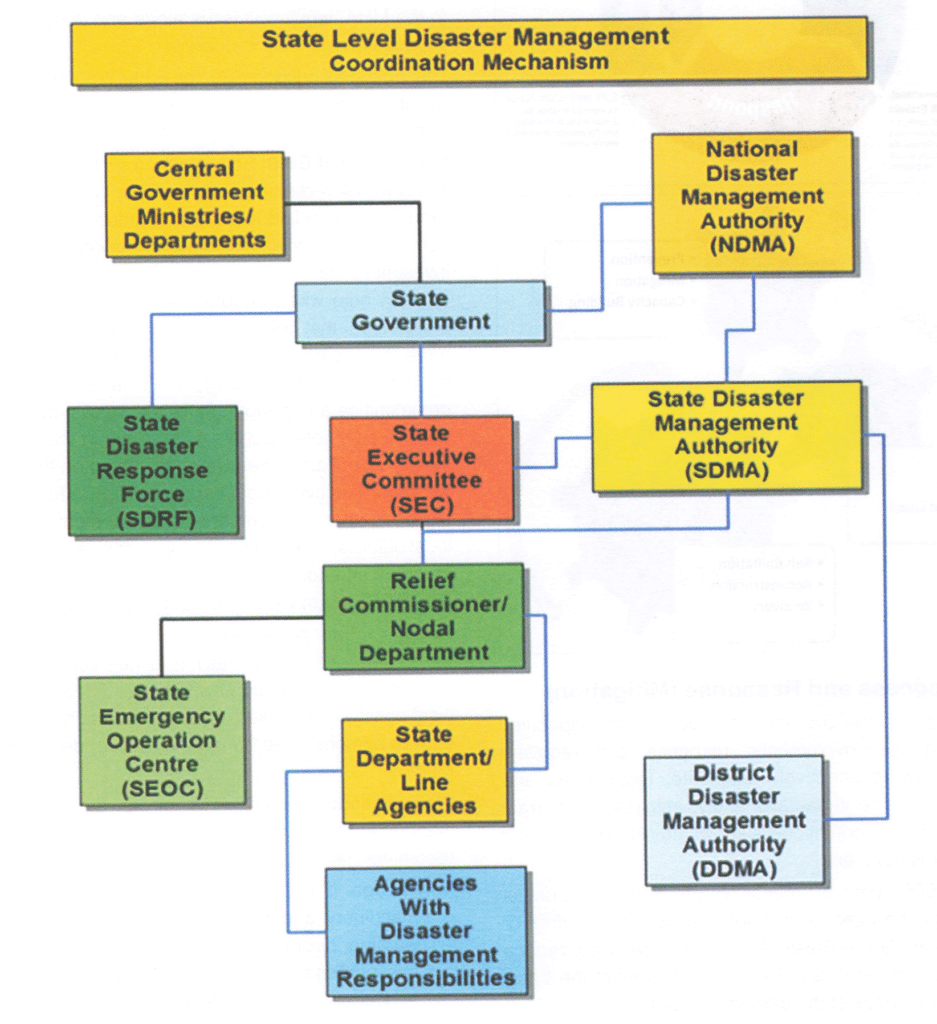
3. District Level
The Disaster Management Act mandates that
- At the district level, District Disaster Management Authority (DDMA), the District Collector or District Magistrate or the Deputy Commissioner, as applicable, will be responsible for overall coordination of the disaster management efforts and planning
- Detailed Disaster Management Plan will be developed, subject to periodic review and revision, at the levels of state, district, towns and blocks (taluka).
- Each State Government shall establish a District Disaster Management Authority for every district in the State.
- The District Disaster Management Authority will act as the planning, coordinating and implementing body for DM at the District level and take all necessary measures for the purposes of DM in accordance with the guidelines laid down by the NDMA and SDMA.
Nodal Ministry for Management / Mitigation of Different Disasters
| Disaster | Nodal Ministry/ Department |
|---|---|
| Biological | Ministry of Health and Family Welfare (MoHFW) |
| Chemical and Industrial | Ministry of Environment, Forests and Climate Change (MoEFCC) |
| Civil Aviation Accidents | Ministry of Civil Aviation (MoCA) |
| Cyclone/Tornado | Ministry of Earth Sciences (MoES) |
| Tsunami | Ministry of Earth Sciences (MoES) |
| Drought/Hailstorm/Cold Wave and Frost/Pest Attack | Ministry of Agriculture and Farmers Welfare (MoAFW) |
| Earthquake | Ministry of Earth Sciences (MoES) |
| Flood | Ministry of Water Resources (MoWR) |
| Forest Fire | Ministry of Environment, Forests, and Climate Change (MoEFCC) |
| Landslides | Ministry of Mines (MoM) |
| Avalanche | Ministry of Defence (MoD) |
| Nuclear and Radiological Emergencies | Department of Atomic Energy (DAE) |
| Rail Accidents | Ministry of Railways (MoR) |
| Road Accidents | Ministry of Road Transport and Highways (MoRTH) |
| Urban Floods | Ministry of Urban Development (MoUD) |
Disaster Risk Reduction
According to UNISDR, Disaster Risk Reduction consists of a framework of elements that will help to minimize vulnerabilities and disaster risks throughout a society, to avoid (prevention) or to limit (mitigation and preparedness) the adverse impacts of hazards, within the broad context of sustainable development.
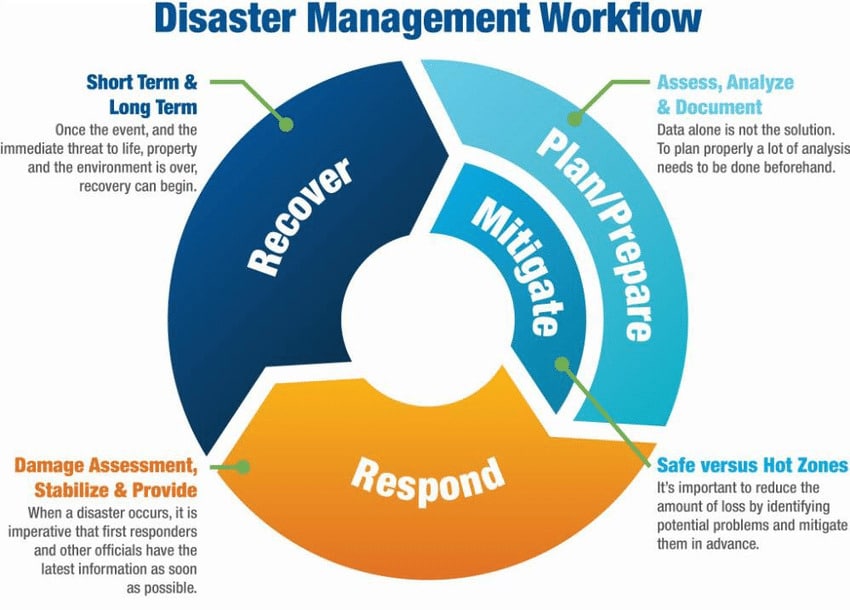
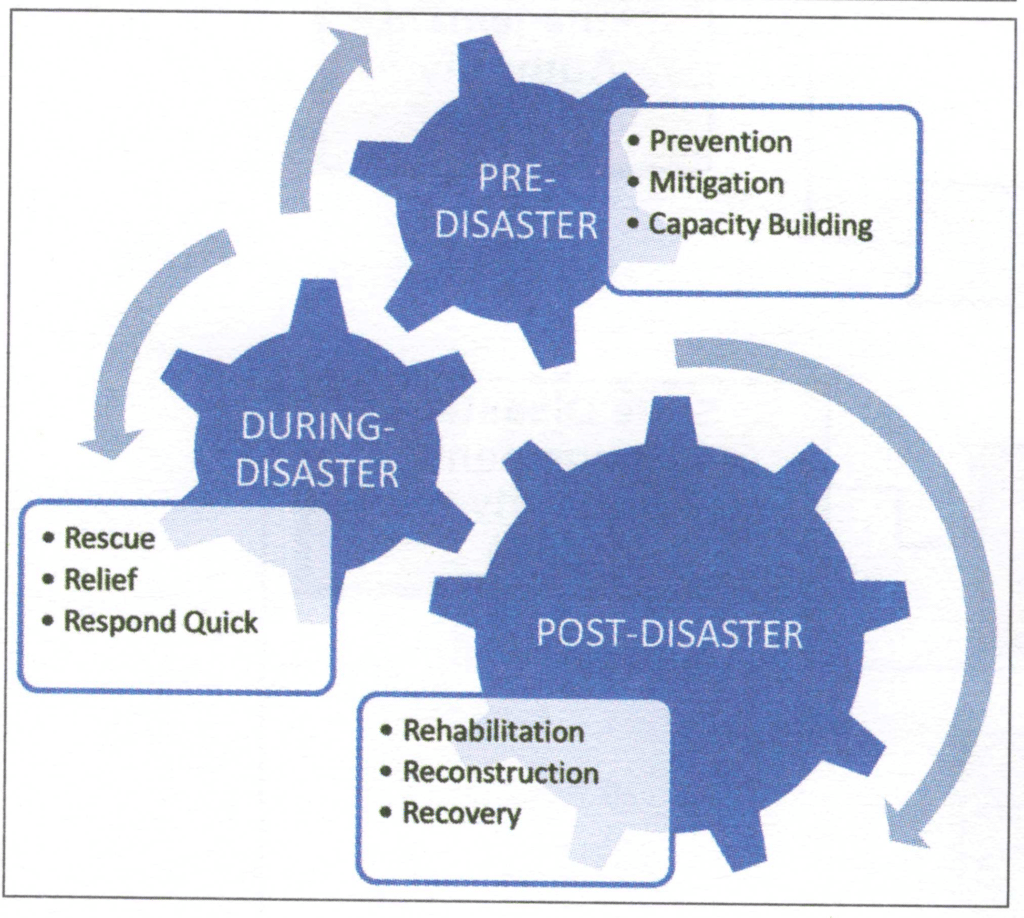
Preparedness and Response (Mitigation)
According to UNISDR , the knowledge and capacities developed by governments, response and recovery organizations to effectively anticipate, respond to, and recover from, the impacts of likely, imminent or current hazard events or conditions is known as preparedness for disaster management. The UNISDR defines response as “the provision of emergency services and public assistance during or immediately after a disaster in order to save lives, reduce health impacts, ensure public safety and meet the basic subsistence needs of the people affected.” The immediate response in the event of a disaster lies with the local authorities with the support of the State Government.
The Union Government supplements their efforts through providing logistic and financial support, deploying NDRF, Armed Forces, CAPF, and other specialized agencies like in case of CBRN disaster. Different measures that shall be taken for preparedness and response are as following :
National Early Warning System
The Government of India has designated specific agencies to monitor the onset of different natural disasters, set up adequate Early Warning Systems (EWS), and disseminate necessary warnings/ alerts regarding any impending hazard, for all those hazards where early warning and monitoring is possible with the currently available technologies and methods. These agencies provide inputs to the MHA, which will issue alerts and warnings through various communication channels
The agencies responsible for Early Warning System will maintain equipment in proper functioning order and conduct simulation drills to test their efficacy.
Importance of EWS: Early warning systems are the key to effective risk reduction. They do save lives and livelihoods (and) in the world we live in, with so much division between rich and poor, they also save an enormous amount of investment for the donor countries that will be called upon to help when people die from such disasters. It is understood that the most effective early warning takes more than scientifically advanced monitoring systems.
All the sophisticated technology won’t matter if we don’t reach communities and people. Satellites, buoys, data networks will make us safer, but we must invest in the training, the institution building, the awareness rising on the ground. If we want effective global early warning systems, we must work together, government to government, federal and local officials, scientists with policy makers, legislators with teachers and community leaders.
Experience: After the Odisha Super Cyclone, advanced Doppler radars have been installed at three locations on the eastern coast which has made the tracking of cyclones more accurate, but such systems are not available in the west coast which makes weather prediction fairly primitive as was demonstrated during the unprecedented rainfall in Mumbai.
Way Ahead: Second ARC in its 3rd Report Crisis management – from Despair to Hope made following
recommendation:
- Though it is the responsibility of the government machinery and the local bodies to disseminate the warning, peoples’ participation has to be enlisted. For this purpose, the role of community leaders, NGOs and others should be clearly defined in the emergency response plan and they should be fully trained and prepared for their respective roles.
- Communications networks with sufficient redundancies should be established between the data collection point to the points where hazard is likely to occur. The communication channels from the
point of alert generation to the point of disaster should have enough redundancies so as to maintain line of communication in the event of a disaster striking. Care has to be taken to put in place systems to disseminate warnings to all sections of the people. - The early warning system should be evaluated after each disaster to carry out further improvements. Following are four components of Early Warning System.

Strengthening Disaster Risk Governance
Disaster Risk governance refers to the way in which public authorities, civil servants, media, private sector, and civil society cooperate in order to manage and reduce disaster and climate related risks.In other words, ensuring that sufficient levels of capacity and resources are made available to prevent, prepare for, manage and recover from disasters. Strengthening disaster risk governance is necessary to foster collaboration and partnerships for the implementation of disaster risk reduction and sustainable development.
The Sendai Framework lays emphasis on the following to strengthen disaster risk governance :
- Mainstream and integrate disaster risk reduction within and across all sectors.
- Adopt and implement disaster risk reduction strategies and plans across different levels.
- Carry out assessment of the technical, financial and administrative disaster risk management capacity to deal with the identified risks at different levels.
- Promote necessary mechanisms and incentives to ensure high levels of compliance with the safety enhancing provisions.
- Empower local authorities, as appropriate, through regulatory and financial mechanism to work and coordinate with civil society.
- Work with parliamentarians for disaster risk reduction by developing or amending relevant legislation and setting budget allocations.
- Formulate relevant public policies and laws aimed at addressing issues of prevention or relocation, where possible, of human settlements in disaster risk-prone zones.
Disaster Recovery
Recovery is “the restoration, and improvement where appropriate facilities for livelihoods and living conditions of disaster-affected communities, including efforts to reduce disaster risk factors. Disaster Management Act 2005 mandates the government to carry out rehabilitation and reconstruction activities, it does not explicitly refer to ‘recovery’ as a component to be used as a part of disaster management strategy.

Rehabilitation
Rehabilitation package includes total reconstruction of damaged physical and psychological infrastructure, as well as economic and social rehabilitation of the people in the affected region. The rehabilitation is classified into the following:
- Physical Rehabilitation: It refers to Reconstruction of physical infrastructure with short term and long term strategies towards watershed management, canal irrigation along with rehabilitating artisan, agriculture and animal husbandry by providing adequate subsidies, farm implements, flood plain zoning, adherence to land use planning.
- Social Rehabilitation: providing special social support to the vulnerable groups by reviving the education activities, rehabilitating olders, women and children etc among others
- Economic Rehabilitation: It include livelihood restoration and ensuring the continuity of businesses, trade, and commerce by restoring employment and income generating opportunities and access to functioning market to disaster affected communities.
- Psychological Rehabilitation: It refers to the psychological trauma of losing relatives and friends, and the scars of the shock of disaster event which take much longer to heal than the stakeholders in disaster management often realize. Thus, counselling for stress management should form a continuous part of a disaster rehabilitation plan. It can include:
- (a) Psycho-therapeutic health programmes.
- (b) Occupational therapy.
- (c) Debriefing and trauma care.
- (d) Tradition, values, norms, beliefs, and practices of disaster-affected people.
Fund Mobilisation
The work of rehabilitation and reconstruction can move forward only if sufficient fund is allocated. These projects are typically financed through the State exchequer. However in recent times, large funds have been raised from multilateral/ bilateral funding agencies/ international agencies in close coordination with the national Governments. The funds can also be raised by imposing special tax or surcharge and issuing tax free bonds.
The State Government, through the relevant ministry of the Central Government, shall finalize the fund mobilization strategy, incorporating appropriate conditions governing flow of funds, its disbursement, and usage as per norms decided by the Central Government. But the funds so allocated shall be disbursed in time and proper monitoring should be done.
As per Section 47 of the DM Act 2005, Central Government may constitute a National Disaster Mitigation Fund for projects exclusively for the purpose of mitigation.
Capacity Development
Capacity development covers strengthening of institutions, mechanisms, and capacities at all levels of all stakeholders. It is an important component of investing in disaster risk reduction.
Capacity development commonly refers to a process that is driven from the inside and starts from existing capacity assets. The framework underlines the need for capacity development of women in disaster management and building their ability to participate effectively in managing disaster risk As capacity development entails activities on various levels, i .e. legal and institutional frameworks, systems
of organisations, organisation and human and material resources, it is necessary to address challenges on all of them by implementing a mix of activities, on short and long term.
These three stages – preparedness and risk management, emergency response and recovery and rehabilitation may be subdivided into various detailed activities as presented in Figure.
Elements of Crisis Management
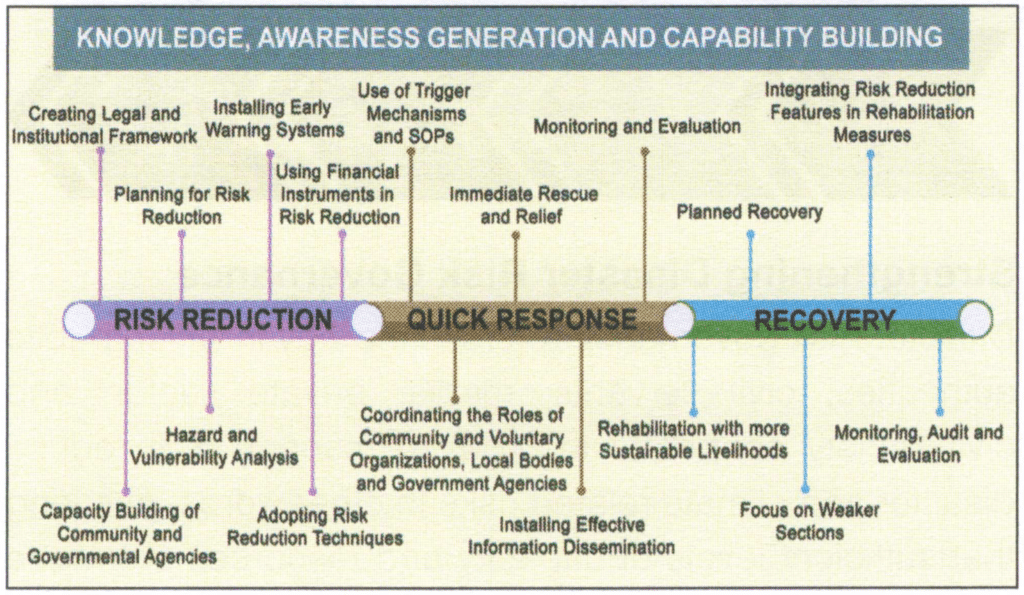
National Disaster Management Plan
The National Disaster Management Plan (NDMP) provides a framework and direction to the government agencies for all phases of disaster management cycle. The NDMP is a “dynamic document” in the sense that it will be periodically improved keeping up with the global best practices and knowledge base in disaster management.
The NDMP provides a framework covering all aspects of the disaster management cycle. It covers disaster risk reduction, mitigation, preparedness, response, recovery, and betterment and reconstruction.
While it focuses primarily on the needs of the government agencies, it envisages all those involved in disaster management including communities and non-government agencies as potential users. Section 11 of the DM Act 2005 mandates that there shall be a National Disaster Management Plan (NDMP) for the whole of India.
The NDMP complies with the National Policy on Disaster Management (NPDM) of 2009 and conforms to the provisions of the DM Act making it mandatory for the Government of India and various central ministries to have adequate DM plans.
Acts and Policies Related to Disaster Management

National Disaster Management Act, 2005
Evolution of the Act
The Government of India (GOI) set up a High-Powered Committee (HPC) in August 1999 and a National Committee after the Gujarat earthquake, for making recommendations on the preparation of Disaster Management plans and suggesting effective mitigation mechanisms. Also the tenth five year plan document for the first time contained a detailed chapter on disaster management. Thus all the efforts finally culminated in 2005 by enactment of the National Disaster Management Act.
Functions and Responsibilities
NDMA, as the apex body, is mandated to lay down the policies, plans and guidelines for Disaster Management to ensure timely and effective response to disasters.
It is entrusted with the following responsibilities:
- Lay down policies on disaster management ;
- Approve the National Plan and plans prepared by the Ministries or Departments of the Government of India in accordance with the National Plan;
- Lay down guidelines to be followed by the State Authorities in drawing up the State Plan and Coordinate the enforcement and implementation of the policy and plans for disaster management.
- Recommend provision of funds for the purpose of mitigation.
- Provide such support to other countries affected by major disasters as may be determined by the Central Government.
National Policy on Disaster Management
NPDM was approved in 2009 with the vision “To build a safe and disaster resilient India by developing a holistic, proactive, multi-disaster oriented and technology driven strategy through a culture of prevention, mitigation, preparedness and response”.
NPDM provides for an integration approach for management with emphasis on building strategic partnerships at various levels. The National Policy on disaster management puts in place an enabling environment for all.
Prime Minister’s Ten Point Agenda on DRR
| 1 | All development sectors must imbibe the principles of disaster risk management |
| 2 | Risk coverage must include all, starting from poor households to SMEs to multi-national corporations to nation states |
| 3 | Women’s leadership and greater involvement should be central to disaster risk management |
| 4 | Invest in risk mapping globally to improve global understanding of Nature and disaster risks |
| 5 | Leverage technology to enhance the efficiency of disaster risk management efforts |
| 6 | Develop a network of universities to work on disaster-related issues |
| 7 | Utilise the opportunities provided by social media and mobile technologies for disaster risk reduction |
| 8 | Build on local capacity and initiative to enhance disaster risk reduction |
| 9 | Make use of every opportunity to learn from disasters and, to achieve that, there must be studies on the lessons after every disaster |
| 10 | Bring about greater cohesion in international response to disasters |
International Cooperation on Disaster Management
International Organisation and Frameworks
Yokohama Strategy (1994)
The need to mitigate the impact of natural disaster in terms of human and economic losses was felt by the United Nations and other countries. So they held World conference on natural Disaster reduction in the city of yokohama in 1994. It was accepted that these disaster affected the poor and disadvantageous group the worst, particularly in the developing countries, which are ill equipped to cope with them.
The resolution of the world conference on natural disaster reduction was as follows:
- Each country has the sovereign responsibility to protect its citizen from natural disasters.
- It would give priority attention to the developing countries, particularly the least developed landlocked countries and Small Island developing Nations.
- It will develop and strengthen National capacities and capabilities.
- It will promote and strengthen sub regional, regional and international cooperation in activities to prevent reduce and mitigate natural and other disasters.
- It also declared the decade 1990-2000 as the international decade for natural disaster reduction.
United Nations office for disaster Risk Reduction (1999)
The UN General Assembly adopted the International Strategy for Disaster Reduction as asuccessor arrangement of the International Decade for Natural Disaster Reduction in December 1999 and established United Nations International Strategy for Disaster Reduction (UNISDR). Its mandate was expanded in 2001 to serve as the focal point in the United Nations system to ensure coordination and synergies among disaster risk reduction activities of the United Nations system and regional organizations.
Hyogo Framework (2005)
The world conference on Disaster Reduction which was held Kobe, Hyogo Japan in 2005 adopted the framework for action 2005-2015.
The hyogo framework for action had the following goals:
- The integration of disaster risk reduction into sustainable development policies and planning.
- Development and strengthening of institutions, mechanism and capacities to build resilience to hazards.
- The systematic incorporation of risk reduction approaches into the implementation of emergency
preparedness, response and recovery programme. Its priority of action included: - Ensure that disaster risk reduction (DRR) is a national and a local priority with a strong institutional basis for implementation.
- Identify, assess and monitor disaster risks and enhance early warning.
- Use knowledge, innovation and education to build a culture of safety and resilience at all level.
- Reduce the underlying risk factors.
- Strengthen disaster preparedness for effective response at all levels.
Sendai Framework (2015)
The Sendai Framework is a 15-year (2015-2030), voluntary, non-binding agreement which recognizes that the State has the primary role to reduce disaster risk but that responsibility should be shared with other stakeholders including local government, the private sector and other stakeholders. The Sendai Framework was adopted by UN Member States on 18 March 2015 at the Third UN World Conference on Disaster Risk Reduction in Sendai City, Miyagi Prefecture, Japan as a follow up of the hyogo framework.
The global targets set by Sendai Framework includes:
- Substantially reduce global disaster mortality by 2030.
- Substantially reduce the number of affected people globally by 2030
- Reduce direct disaster economic loss in relation to global gross domestic product (GDP) by 2030.
- Substantially reduce disaster damage to critical infrastructure and disruption of basic services, among them health and educational facilities, including through developing their resilience by 2030.
- Substantially increase the number of countries with national and local disaster risk reduction strategies by 2020.
- Substantially enhance international cooperation to developing countries through adequate and sustainable support to complement their national actions for implementation of this Framework by 2030.
- Substantially increase the availability of and access to multi-hazard early warning systems and disaster risk information and assessments to the people by 2030.
The four priority areas for action in sendai framework are as:
- Understanding Disaster Risk: Disaster risk management should be based on an understanding
of disaster risk in all its dimensions of vulnerability, capacity, exposure of persons and assets, hazard characteristics and the environment. Such knowledge can be used for risk assessment, prevention, mitigation, preparedness and response. - Strengthening Disaster Risk Governance: Disaster risk governance at the national, regional and global levels is very important for prevention, mitigation, preparedness, response, recovery, and rehabilitation. It fosters collaboration and partnership.
- Investing in Disaster Risk Reduction: Public and private investment in disaster risk prevention and reduction through structural and non-structural measures are essential to enhance the economic, social, health and cultural resilience of persons, communities, countries and their assets, as well as the environment.
- Enhancing Disaster Preparedness: The growth of disaster risk means there is a need to strengthen disaster preparedness for response, take action in anticipation of events, and ensure capacities are
in place for effective response and recovery at all levels. The recovery, rehabilitation and reconstruction phase is a critical opportunity to build back better, including through integrating disaster risk reduction into development measures.
The NDMP incorporated the four priority areas and substantively the approach enunciated in the Sendai Framework which will help the country to meet the goals set in the framework. The NDMP has been aligned broadly with the goals and priorities set out in the Sendai Framework for Disaster risk reduction.
The Sendai Framework Readiness Review, UNISDR 2017: Critical data gaps exist in specific areas of disaster loss, in all areas of international cooperation, and for many aspects of early warning, risk information and disaster risk reduction strategies. The Review confirms that unless gaps in data availability, quality and accessibility are addressed, countries’ ability to assure accurate, timely and high quality monitoring and reporting of implementation across all Targets and Priorities of the Sendai Framework will be severely impaired.
A Global Partnership for Disaster-related Data for Sustainable Development would facilitate a collaborative, multi-stakeholder effort (bringing together governments, international organizations, the private sector, civil society groups, and the statistics and data communities), to optimize and operationalize existing and future disaster-related data in support of national and sub-national disaster risk reduction efforts.
2030 Agenda for Sustainable Development: In the 2030 Agenda for Sustainable Development, ten of the seventeen Sustainable Development Goals (SDGs) have targets related to disaster risk, firmly establishing the role of disaster risk reduction in realizing the 2030 Agenda for Sustainable Development.
Paris Agreement at CoP 21: In the Paris Agreement, adopted at the 21st Conference of Parties to United Nations Framework Convention on Climate Change in 2015, Member States committed to holding the global average temperature increase to well below 2°C above pre-industrial levels and to pursue efforts to limit the increase to 1.5°C, with the aim to “significantly reduce the risks and impacts of climate change”.
Facts About Disasters and its Management
- About 10 per cent of the World’s tropical cyclones affect the Indian coast.
- In India, tropical cyclones occur in the months of May-June and October-November.
- The North Indian Ocean Basin (NIO-Basin, including the Indian coast) generates about seven percent of the World’s cyclones.
- It has been observed that between 1891 and 2006, 308 cyclones crossed the east coast, out of which 103 were severe
- Out of 40 million hectare of the flood prone area in the country, on an average, floods affect an area of around 7.5 million hectare per year.
- It is estimated that 30 percent of the World’s landslides occur in the Himalayan ranges.
- Around 68% of India’s land is prone to drought.
- Nearly 60% land marks is prone to earthquake.
- Approximately 76% of the 7516 km of India’s coast line is affected by cyclones and tsunamis.
Problems in Disaster Management
| Infrastructural-Physical & Human | Lack of knowledge and awareness among the citizens of India regarding the kind of disaster and ways to mitigate and respond to the problem. Lack of expertise in the effective management of disasters at all the levels in general and at local levels in particular. Insufficient and inefficient preparedness by the residents for any natural calamity particularly in vulnerable zones |
| Institutional Governance | Infrastructure and technological systems have politics. For example, often there are contention seen in the construction of dams between the government agencies and the residents of the areas in the vulnerable areas. There is little coordination and sharing of data among different ministries and between the government and agencies involved in disaster risk management. |
Disaster Mitigation
Some of the ways to mitigate the Disaster problems include:
| Infrastructural-Physical & Human | Improvement to be brought in effective processes, such as continuous training, multiple redundancies, accountability, better data, hierarchical differentiation and autonomy, and crucially, nurturing cultures of reliability. Perform drill practices to train people about the response, measures and care to be taken of in case of any disaster. Preparation of location specific and disaster specific centres should be open to provide services in the time of disaster. |
| Institutional Governance | Understanding the patterns in human social dynamics in any given region. Involve NGOs and SHGs to spread awareness among the residents by campaigning and other such methods. Democratic processes and shareholder participation are critical for effective Disaster risk governance. Time to move on from being focussed only on managing disaster emergencies to improve resilience. |
